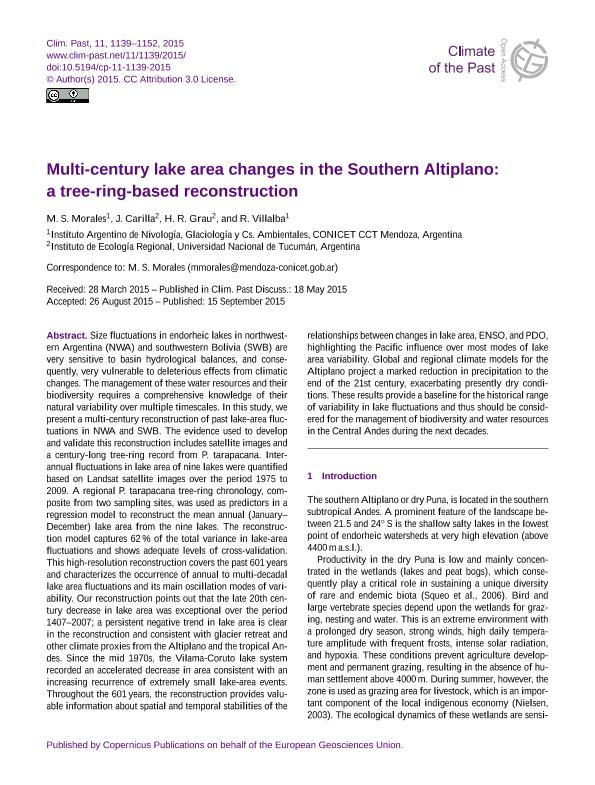Artículo
Multi-century lake area changes in the Southern Altiplano: A tree-ring-based reconstruction
Fecha de publicación:
15/09/2015
Editorial:
Copernicus Publications
Revista:
Climate Of The Past
ISSN:
1814-9324
e-ISSN:
1814-9332
Idioma:
Inglés
Tipo de recurso:
Artículo publicado
Clasificación temática:
Resumen
Size fluctuations in endorheic lakes in northwestern Argentina (NWA) and southwestern Bolivia (SWB) are very sensitive to basin hydrological balances, and consequently, very vulnerable to deleterious effects from climatic changes. The management of these water resources and their biodiversity requires a comprehensive knowledge of their natural variability over multiple timescales. In this study, we present a multi-century reconstruction of past lake-area fluctuations in NWA and SWB. The evidence used to develop and validate this reconstruction includes satellite images and a century-long tree-ring record from P. tarapacana. Inter-annual fluctuations in lake area of nine lakes were quantified based on Landsat satellite images over the period 1975 to 2009. A regional P. tarapacana tree-ring chronology, composite from two sampling sites, was used as predictors in a regression model to reconstruct the mean annual (January-December) lake area from the nine lakes. The reconstruction model captures 62 % of the total variance in lake-area fluctuations and shows adequate levels of cross-validation. This high-resolution reconstruction covers the past 601 years and characterizes the occurrence of annual to multi-decadal lake area fluctuations and its main oscillation modes of variability. Our reconstruction points out that the late 20th century decrease in lake area was exceptional over the period 1407-2007; a persistent negative trend in lake area is clear in the reconstruction and consistent with glacier retreat and other climate proxies from the Altiplano and the tropical Andes. Since the mid 1970s, the Vilama-Coruto lake system recorded an accelerated decrease in area consistent with an increasing recurrence of extremely small lake-area events. Throughout the 601 years, the reconstruction provides valuable information about spatial and temporal stabilities of the relationships between changes in lake area, ENSO, and PDO, highlighting the Pacific influence over most modes of lake area variability. Global and regional climate models for the Altiplano project a marked reduction in precipitation to the end of the 21st century, exacerbating presently dry conditions. These results provide a baseline for the historical range of variability in lake fluctuations and thus should be considered for the management of biodiversity and water resources in the Central Andes during the next decades.
Palabras clave:
Climate Change
,
Lake Level
,
Polylepis
,
Dendrochronology
Archivos asociados
Licencia
Identificadores
Colecciones
Articulos(CCT - NOA SUR)
Articulos de CTRO.CIENTIFICO TECNOL.CONICET - NOA SUR
Articulos de CTRO.CIENTIFICO TECNOL.CONICET - NOA SUR
Articulos(IANIGLA)
Articulos de INST. ARG. DE NIVOLOGIA, GLACIOLOGIA Y CS. AMBIENT
Articulos de INST. ARG. DE NIVOLOGIA, GLACIOLOGIA Y CS. AMBIENT
Citación
Morales, Mariano Santos; Carilla, Julieta; Grau, Hector Ricardo; Villalba, Ricardo; Multi-century lake area changes in the Southern Altiplano: A tree-ring-based reconstruction; Copernicus Publications; Climate Of The Past; 11; 9; 15-9-2015; 1139-1152
Compartir
Altmétricas




